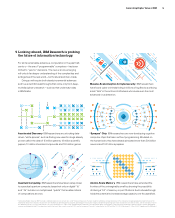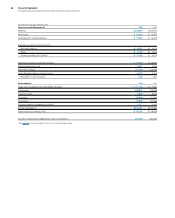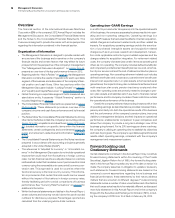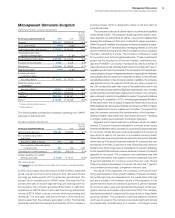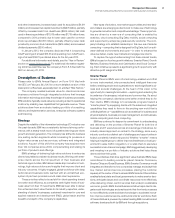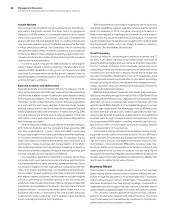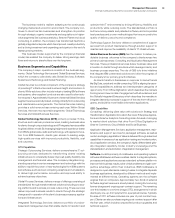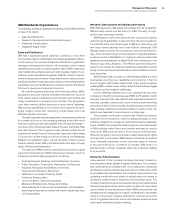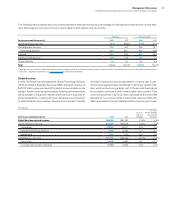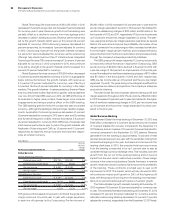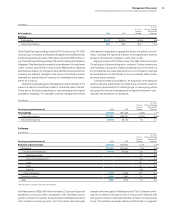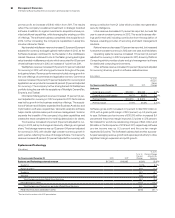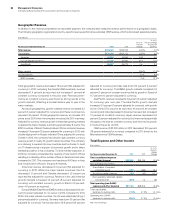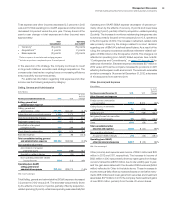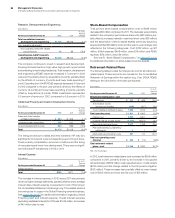IBM 2012 Annual Report Download - page 26
Download and view the complete annual report
Please find page 26 of the 2012 IBM annual report below. You can navigate through the pages in the report by either clicking on the pages listed below, or by using the keyword search tool below to find specific information within the annual report.25
Management Discussion
International Business Machines Corporation and Subsidiary Companies
IBM Worldwide Organizations
The following worldwide organizations play key roles in IBM’s delivery
of value to its clients:
• Sales and Distribution
• Research, Development and Intellectual Property
• Enterprise Transformation
• Integrated Supply Chain
Sales and Distribution
IBM has a significant global presence, operating in more than
170 countries, with an increasingly broad-based geographic distribu-
tion of revenue. The company’s Sales and Distribution organization
manages a strong global footprint, with dedicated country-based
operating units focused on delivering client value. Within these units,
client relationship professionals work with integrated teams of con-
sultants, product specialists and delivery fulfillment teams to improve
clients’ business performance. These teams deliver value by under-
standing the clients’ businesses and needs, and then bring together
capabilities from across IBM and an extensive network of Business
Partners to develop and implement solutions.
By combining global expertise with local experience, IBM’s
geographic structure enables dedicated management focus for
local clients, speed in addressing new market opportunities and
timely investments in emerging opportunities. The geographic
units align industry-skilled resources to serve clients’ agendas.
IBM extends capabilities to mid-market client segments by lever-
aging industry skills with marketing, Inside Sales and local
Business Partner resources.
Through its growth markets organization, the company continues
to increase its focus on the emerging markets around the world
that have market growth rates greater than the global average—
countries within Southeast Asia, Eastern Europe, the Middle East
and Latin America. The company’s major markets include the G7
countries of Canada, France, Germany, Italy, Japan, the United States
(U.S.) and the United Kingdom (UK) plus Austria, the Bahamas,
Belgium, the Caribbean region, Cyprus, Denmark, Finland, Greece,
Iceland, Ireland, Israel, Malta, the Netherlands, Norway, Portugal,
Spain, Sweden and Switzerland.
The majority of IBM’s revenue, excluding the company’s original
equipment manufacturer (OEM) technology business, occurs in
industries that are broadly grouped into six sectors:
• Financial Services: Banking, Financial Markets, Insurance
• Public: Education, Government, Healthcare, Life Sciences
• Industrial: Aerospace and Defense, Automotive,
Chemical and Petroleum, Electronics
• Distribution: Consumer Products, Retail,
Travel and Trans portation
• Communications: Telecommunications,
Media and Entertain ment, Energy and Utilities
• General Business: Cross-sector representation of intermediate-
sized large enterprises as well as mid-market clients (less than
1,000 employees)
Research, Development and Intellectual Property
IBM’s R&D operations differentiate the company from its competitors.
IBM annually invests over $6 billion for R&D, focusing on high-
growth, high-value opportunities.
IBM Research works with clients and the company’s business
units through 12 global labs on near-term and mid-term innovations.
It contributes many new technologies to IBM’s portfolio every year
and helps clients address their most difficult challenges. IBM
Research also explores the boundaries of science and technol-
ogy—from nanotechnology, to future systems, to big data analytics,
to secure clouds, to IBM Watson, a “cognitive” learning system that
applied advanced analytics to defeat the all-time champions on the
television quiz show, Jeopardy!. The Watson system is being intro-
duced to the market for advanced healthcare applications and is
being further developed and extended within healthcare and in
other industries.
IBM Research also focuses on differentiating IBM’s services
businesses providing new capabilities and solutions. It has the
world’s largest mathematics department of any public company,
enabling IBM to create unique analytic solutions and actively engage
with clients on their toughest challenges.
In 2012, IBM was awarded more U.S. patents than any other
company for the 20th consecutive year. IBM’s 6,478 patents in 2012
included inventions that will enable fundamental advancements in
analytics, big data, cybersecurity, cloud, mobile, social networking
and software defined environments, as well as industry solutions for
retail, banking, healthcare and transportation. It was the most U.S.
patents ever awarded to one company in a single year.
The company continues to actively seek intellectual property
protection for its innovations, while increasing emphasis on other
initiatives designed to leverage its intellectual property leadership.
Some of IBM’s technological breakthroughs are used exclusively
in IBM products, while others are licensed and may be used in
either/both IBM products and/or the products of the licensee.
While the company’s various proprietary intellectual property rights
are important to its success, IBM believes its business as a whole
is not materially dependent on any particular patent or license,
or any particular group of patents or licenses. IBM owns or is
licensed under a number of patents, which vary in duration, relating
to its products.
Enterprise Transformation
A key element of the company’s strategy has been focused on
becoming the premier globally integrated enterprise. The company
has implemented a consistent set of processes and standards
worldwide to reduce inefficiencies and improve collaboration. With
its processes fully standardized, the company implemented a new
operating model with work shared in global resource centers of
excellence located where it made the most business sense. The
company has shifted resources toward building client relationships
and employee skills, while positioning the company for new market
opportunities. During this transformation, IBM pioneered this new
operating model, changing from a classic “multinational,” with smaller
versions of the parent company replicated in countries around the
world, to a global model with one set of processes, shared services
and broadly distributed decision making.


